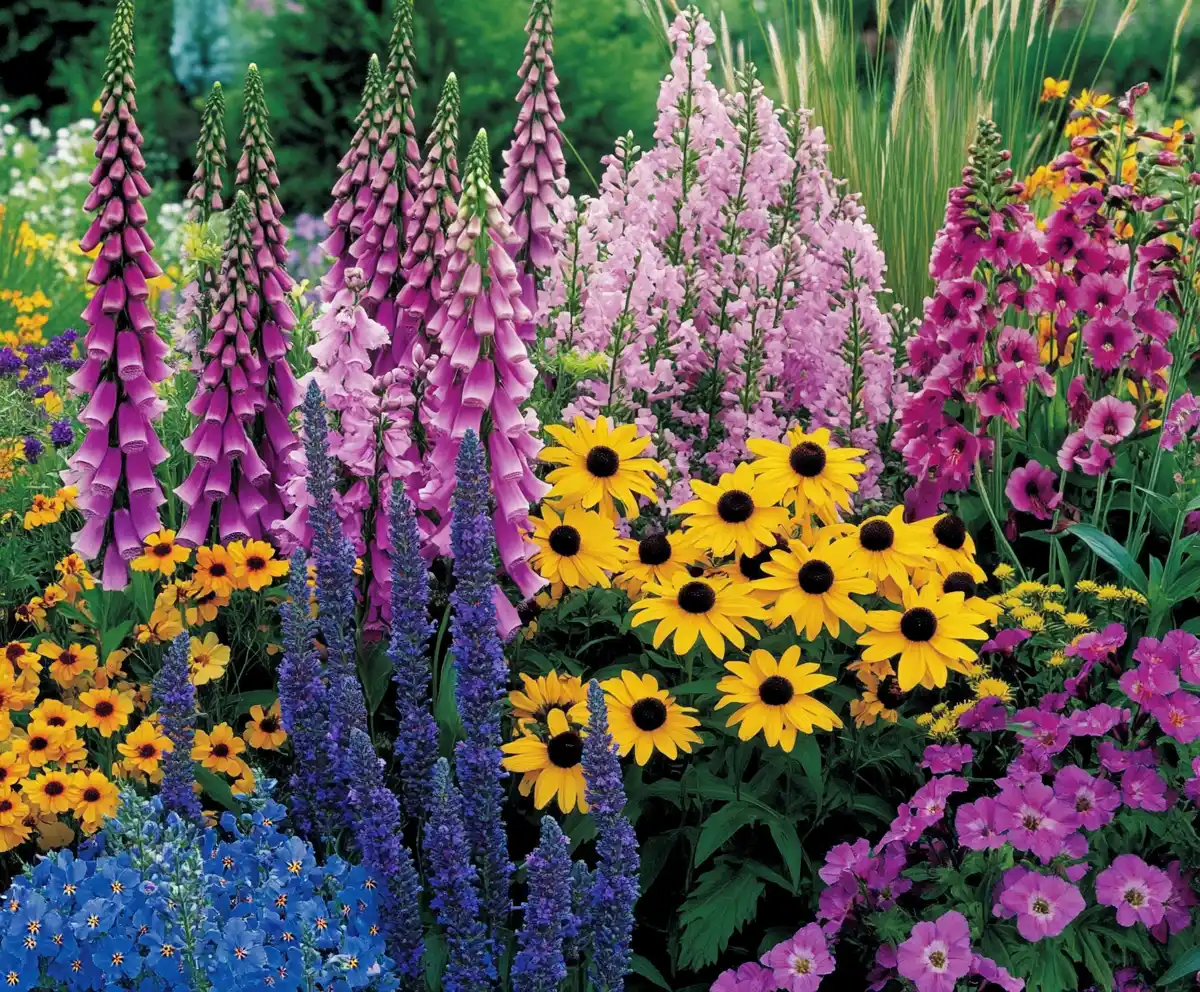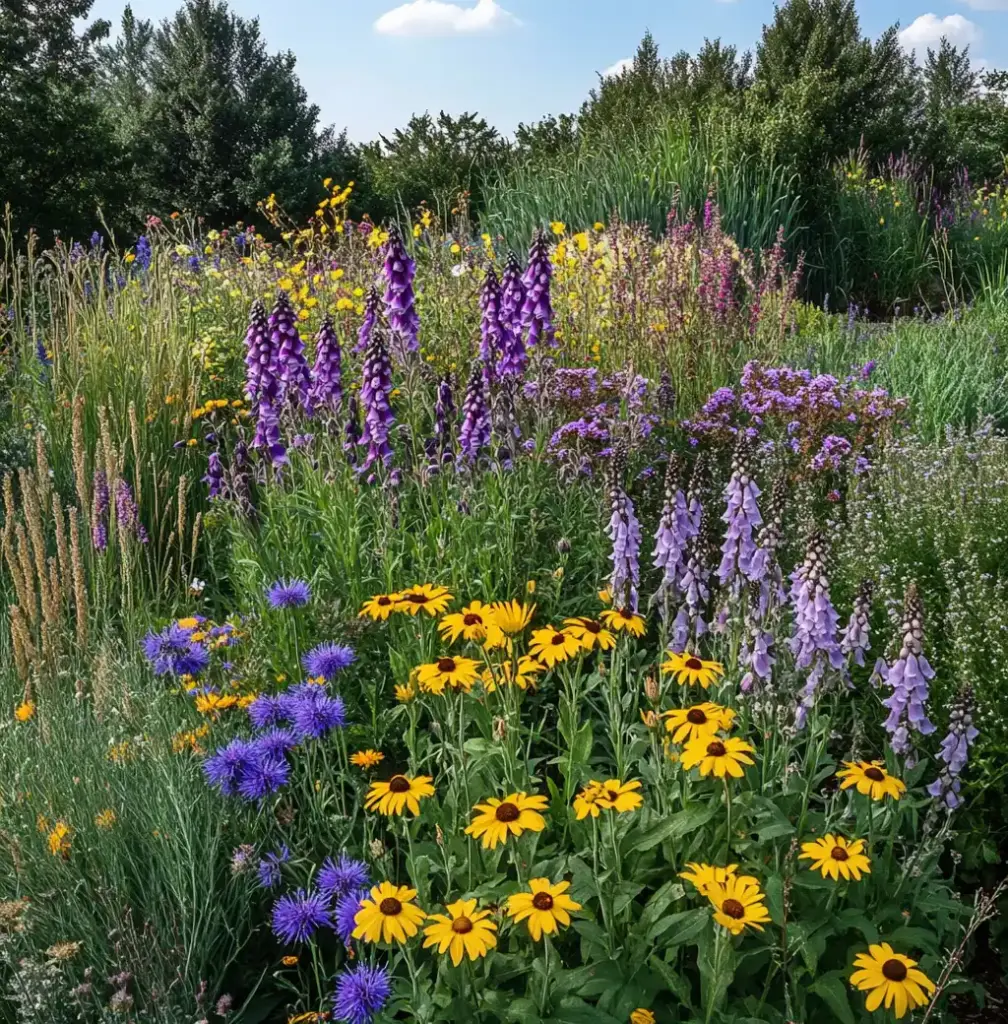If your yard receives full sunlight for most of the day, it’s the ideal setting for a sun-loving garden plan. Instead of struggling with harsh heat and intense rays, a well-designed sun-loving garden plan takes advantage of them—transforming those bright spaces into vibrant, low-maintenance gardens filled with lasting color. By incorporating hardy perennials that thrive in high light and return each year, you’ll enjoy a blooming landscape that needs minimal effort to maintain.
This thoughtful sun-loving garden plan is perfect for homeowners seeking beauty that lasts beyond a single season. It layers textures, colors, and plant heights for visual appeal and performance, even in challenging full-sun conditions. Whether you’re revamping an existing area or starting from scratch, this sun-loving garden plan offers a reliable and rewarding foundation. For additional ideas, explore our guide to full-sun perennial flowers and discover drought-tolerant plants that thrive in similar environments.
🌿 Love gardening inspiration? Follow me on Pinterest for bold plant ideas, tips, and seasonal color!
Table of Contents
🌿 Plant List in the Sun-Loving Garden Plan
The success of this sun-loving garden plan lies in its carefully curated mix of perennial plants—each chosen for its resilience, vibrant blooms, and ability to return year after year. These plants not only stand up to intense sunlight but also offer continuous color, texture, and pollinator appeal from early summer through fall.
🌸 New England Aster (Symphyotrichum novae-angliae)
- Zones: 4–8
- Bloom Time: Late summer to fall
- Why It Works: This native wildflower brings a burst of purple-pink hues late in the season, attracting butterflies and providing a strong finish to the garden’s color display.
🌼 Tickseed (Coreopsis ‘Lil Bang Daybreak’)
- Zones: 4–9
- Bloom Time: Early to late summer
- Why It Works: Bright yellow petals with reddish centers create cheerful pops of color. It’s a drought-tolerant option that thrives in tough conditions.
🌺 Coneflower (Echinacea purpurea ‘PowWow Wild Berry’)
- Zones: 3–9
- Bloom Time: Mid to late summer
- Why It Works: A pollinator magnet! This variety has vibrant magenta blooms that are both ornamental and beneficial to local bees and butterflies.
🌾 Hollyhock (Alcea rosea)
- Zones: 3–9
- Bloom Time: Midsummer
- Why It Works: Towering spires make it a natural backdrop plant. Though technically a biennial, hollyhocks often reseed themselves for recurring appearances.
🌟 Blazing Star (Liatris spicata ‘Floristan Weiss’)
- Zones: 4–9
- Bloom Time: Mid to late summer
- Why It Works: Adds architectural flair with its upright white flower spikes. Loved by pollinators and ideal for vertical interest.
🦋 Butterfly Bush (Buddleia ‘Chrysalis Blue’)
- Zones: 6–9
- Bloom Time: All summer
- Why It Works: True to its name, this bush draws butterflies in droves. The compact variety fits well in smaller beds without overwhelming the space.
💜 Russian Sage (Perovskia atriplicifolia)
- Zones: 5–9
- Bloom Time: Late summer
- Why It Works: Silvery foliage and violet blooms offer a soft, airy contrast to denser plantings. It’s heat- and drought-resistant.
🍁 Sedum ‘Autumn Joy’
- Zones: 3–10
- Bloom Time: Late summer to fall
- Why It Works: A reliable groundcover with succulent-like leaves and clusters of rosy flowers. Excellent for filling gaps in the front of the border.
🌿 Lavender (Lavandula angustifolia ‘SuperBlue’)
- Zones: 5–8
- Bloom Time: Early to mid-summer
- Why It Works: Aromatic, calming, and beautiful. Lavender’s soft purple blooms and fragrant foliage enhance the sensory experience of your garden.
These perennials were chosen not just for their durability, but for the way they work together—forming a harmonious blend of heights, textures, and continuous color. Whether you’re going for a bold pollinator haven or a calming cottage garden vibe, this sun-loving garden plan delivers.
🧱 Design Tips: How to Layout Your Sun-Loving Garden Plan
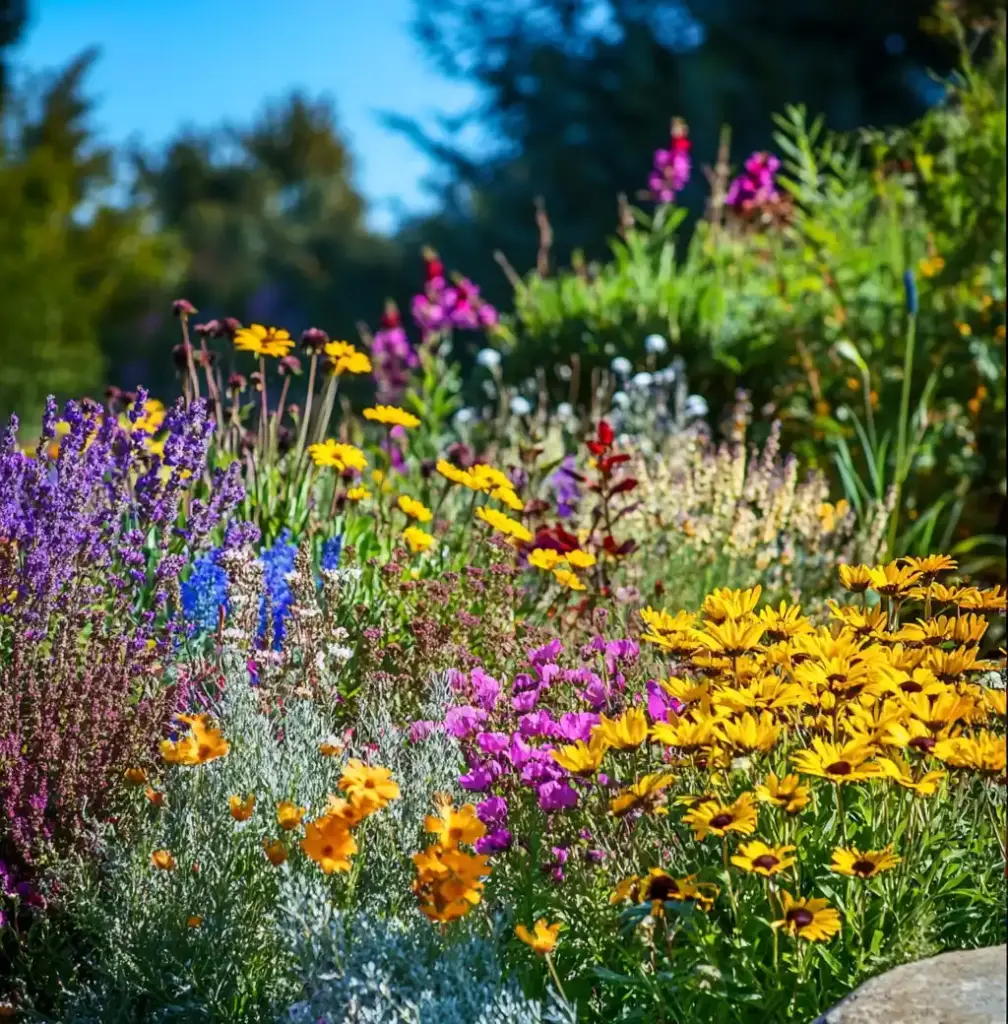
A thoughtful garden layout can turn a basic flowerbed into a stunning, layered display that feels both intentional and effortless. This sun-loving garden plan follows time-tested design principles to help each plant shine in its optimal position, ensuring balance, visual interest, and year-round appeal.
🌿 Layer by Height
Back of the Bed (Tall Plants):
- Hollyhock, Russian Sage, and Butterfly Bush
These tall growers create a natural backdrop and give the garden vertical drama. Position them along fences, walls, or the northernmost edge of your space to avoid shading shorter plants.
Middle Layer (Medium-Height Plants):
- Tickseed, Blazing Star, and Coneflower
These mid-sized bloomers form the heart of the composition. Their bright colors and sturdy stems add bulk and vibrancy to the central view.
Front of the Bed (Low-Growing Plants):
- Lavender, Sedum ‘Autumn Joy’, and New England Aster
Compact and tidy, these plants fill in edges and gaps, helping the bed look full and polished while softening hard borders.
📏 Adapt the Layout to Fit Your Space
- Use the suggested plant list as a flexible guide—feel free to swap in similar-sized, sun-tolerant plants with comparable bloom colors or shapes.
- Scale the design up or down by adjusting plant quantities, while maintaining height-based layering.
- For smaller yards, consider grouping plants in clusters of three for a natural look without crowding.
🛠 Soil Prep and Site Selection
Before planting, assess your site’s conditions to ensure success:
- Choose a location that gets 6+ hours of direct sunlight daily.
- Ensure the soil is well-draining, especially if you’re working with clay or sand.
- Amend with compost or organic matter to improve structure and nutrient content.
- Do a soil test to check pH and nutrient levels—many of these perennials prefer slightly alkaline to neutral soil.
🐝 Bonus Tip: Think Pollinator-Friendly
This plan naturally supports bees, butterflies, and other pollinators. To enhance this, avoid using pesticides and allow some spent flowers to go to seed.
This smart layout, combined with durable plants and minimal maintenance needs, makes your sun-loving garden plan as rewarding as it is resilient.
🌼 Conclusion: Let the Sunshine In
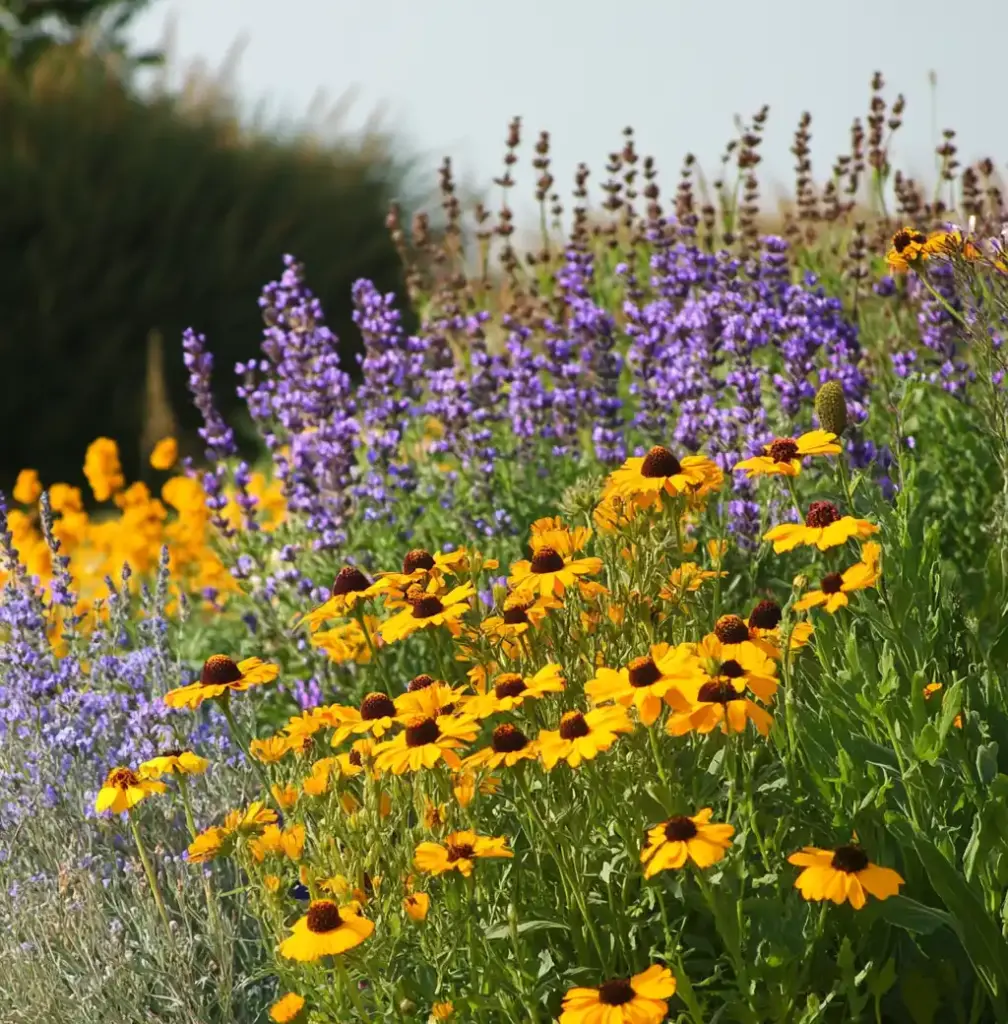
Creating a garden that thrives under intense sunlight isn’t a challenge—it’s a golden opportunity. With smart plant selection, a strategic layout, and minimal upkeep, a well-crafted sun-loving garden plan can transform the sunniest areas of your yard into stunning, long-lasting displays of color, texture, and pollinator-friendly blooms.
This sun-loving garden plan is not only perfect for beginners but also incredibly adaptable. Whether you’re working with a large backyard border or a compact front porch garden, combining hardy full-sun perennials with thoughtful layering will give you a landscape that feels vibrant and full from season to season.
So embrace the sunlight and bring your outdoor space to life with a sun-loving garden plan that’s designed to flourish.
❓ Frequently Asked Questions About Sun-Loving Garden Plans
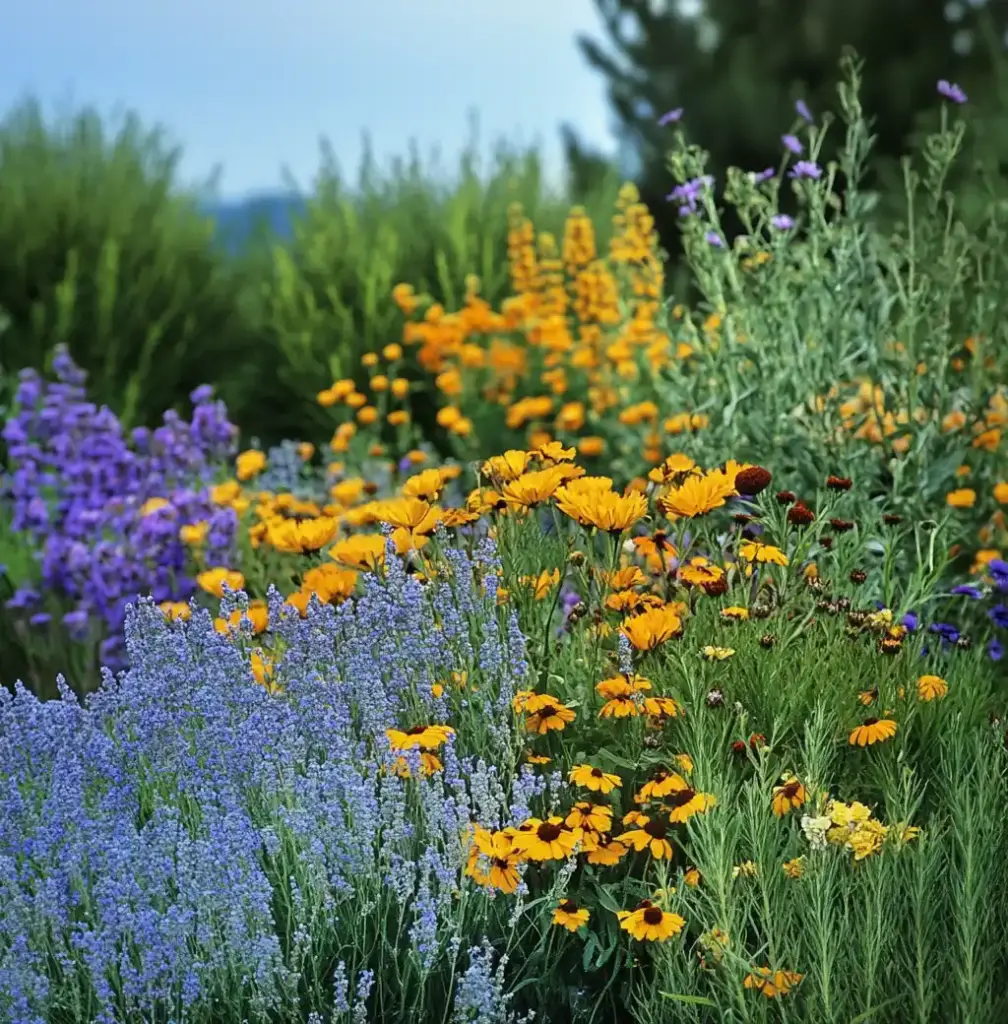
1. What is a sun-loving garden plan?
A sun-loving garden plan is a landscape design that uses plants which thrive in full sunlight—typically six or more hours of direct sun per day. These plants are heat-tolerant, often drought-resistant, and require minimal upkeep.
2. What plants do best in full sun all day?
Some of the best perennials for full sun include coneflowers, Russian sage, butterfly bush, tickseed, lavender, sedum, and blazing star. These plants are not only beautiful but also resilient in hot, sunny conditions.
3. How do I prepare soil for a sun garden?
Start by ensuring good drainage. If your soil is sandy or clay-heavy, amend it with compost or organic matter. A soil test can also help you determine pH levels and nutrient needs for optimal plant health.
4. Can I plant a sun-loving garden in a small space?
Absolutely! Scale down the plan by reducing the number of plants and choosing compact varieties. Use layering techniques—tall in back, medium in the middle, low in front—for a full look, even in tight spaces.
5. How do I keep my sun garden low-maintenance?
Choose perennial plants that are native or well-adapted to your climate. Mulch regularly to retain moisture and suppress weeds, and deadhead spent blooms to encourage more flowers with less effort.

